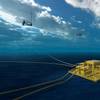Schlumberger has affirmed its commitment to the deepwater market with launch of the DeepSTIM II - the second in a new line of advanced stimulation vessels for deepwater service. The new vessel surpasses the size of the first DeepSTIM by 10 ft., making it the largest stimulation vessel operating in the Gulf of Mexico.
The new-generation DeepSTIM design integrates Schlumberger expertise in marine, mechanical, electronic and chemical engineering, and DeepSTIM II incorporates design improvements made after the first vessel was launched in 1999. Measuring 270 x 56 ft., the vessel's large capacity provides reliability in severe weather and allows the vessel to remain at sea for long periods.
The fully enclosed North Sea-style deck encompasses all pumping, mixing and blending equipment, eliminating exposure of equipment and personnel to weather. Equipped with the latest in antiroll systems, environmental waste containment, data acquisition and transmission, and fluid engineering, DeepSTIM II represents the culmination of stimulation and deepwater service technology.
The dynamic positioning system keeps the vessel in place using computer-aided thrusters built into the hull. Both satellite global positioning and a sonar system help assure operations continue in adverse weather to avoid costly downtime.
Doug Pferdehirt, Schlumberger GeoMarket manager, Gulf Coast, says the new vessels are making designs for deepwater stimulation safer, for both personnel and the environment, as well as more efficient. According to Pferdehirt, "The vessel's size and capacity were not our only considerations. We considered safety, ergonomics and environmental protection as principal drivers in the overall design. The DeepSTIM II has exceptionally large capacities for storage of proppant and fluids, and these capacities and its hydraulic horsepower (hhp) are unmatched by any other stimulation vessel in the Gulf of Mexico. DeepSTIM II capabilities virtually eliminate stimulation design constraints based on vessel limitations."
The vessel delivers 21,400 hhp at rates as high as 50 barrels per minute. A process-controlled continuous-mix fluid system mixes acid and fracturing fluids "on the fly" using fresh water or seawater, greatly minimizing fluid waste and reducing material costs. The DeepSTIM II high-speed satellite communications package allows real-time transmission of critical wellsite data to multiple client locations.
DeepSTIM II joins the DeepSTIM in the Gulf of Mexico, where the first in this new line of stimulation vessels has been working for various operators since its launch a year ago.
Featured videos

Send in the Drones (to deep, dark, confined maritime spaces)

Taking the First Step Toward Autonomy
October 2024
 Read the Magazine
Read the Magazine

 Read the Magazine
Read the Magazine
This issue sponsored by:

Congestion, Emissions, Highway Construction and Engineering Ethics
Subscribe for
Maritime Reporter E-News
Maritime Reporter E-News is the maritime industry's largest circulation and most authoritative ENews Service, delivered to your Email five times per week









